It is easy to fall in love with Istanbul... perhaps
even to fall in love in Istanbul...
Opposite the tourist information kiosk in Sultanahmet is the
Pudding Shop. Opened in 1957, the Pudding Shop became particularly popular in
the 60s with those on the hippie trail between Europe and Asia. In 1978, it was
featured in the movie Midnight Express,
which contributed to its growing reputation. In 1984, on my first visit to
Istanbul, I often breakfasted in the mornings or partied in the evenings at
this vibrant little place and over a beer here reminisced with Charl about my
three weeks in the city that year. I had stayed in a six-bed dorm in a nearby youth
hostel. The occupants of the other five beds came and went and I grew
accustomed to their stories each evening of the drugs they had been offered on
the street. I was never once offered drugs in Istanbul, or perhaps simply did
not understand the terminology. I made Charl laugh when I complained that all I
was offered was sex. When I told the waiter who served us that I had been a
regular visitor to the Pudding Shop 30 years ago, he said he had been a waiter there
for 35 years. Running a hand over his clean-shaven face and balding head, he
asked if I recognised him, adding that he had dark hair and a moustache in
1984...
Named Constantinople from 330AD until 1930, modern Istanbul
has a population of 14 million. Colonised by the Greeks in 685BC, the city fell
to the Romans in 196AD and was officially proclaimed the new capital of the
Roman Empire in 330 by Constantine the Great. Constantine converted to
Christianity and at the end of his reign declared his three sons joint heirs of
the Roman Empire. Family rivalry led eventually to the permanent partition of
the empire with Constantinople becoming the capital of the Eastern Roman
Empire. In the fifth century, while the western empire declined, the eastern
flourished. Classified later as the Byzantine Empire, the eastern empire was
distinctly Greek in culture and became the centre of Greek Orthodox
Christianity following an earlier religious split with Rome. Wikipedia: “The
most famous Byzantine emperor was Justinian (527-565). During his reign he
extended the Byzantine Empire to its largest boundaries spreading from
Palestine to the tip of Spain.” In 1204, the Fourth Crusade planned to capture
both the Byzantine Empire and the Holy City of Jerusalem; it succeeded in the
former, but failed in the latter. The new Latin Empire at Constantinople lasted
until 1261, when the Byzantines recaptured the city. “After this,
Constantinople never regained its former glory. Rather than a thriving
metropolis, Constantinople transformed into a collection of villages.”
In May 1453, after a 53-day siege, Constantinople fell to
Sultan Mehmed the Conqueror becoming the third capital of the Ottoman Empire
and remaining so until the empire’s collapse in 1922. The battle for the city
was dramatic and included Mehmed transporting 80 of his ships overland on a
path of oiled tree branches to place them behind enemy lines. “Mehmed issued
orders across his empire that Muslims, Christians, and Jews should resettle the
city...” and in 1459 ordered that Greeks who had left the city as slaves or
refugees should be allowed to return. An Italian community near the Galata
Tower added to Constantinople’s cosmopolitan flavour and growing population.
“The capital of an empire that stretched across Europe, Asia and Africa,
[Constantinople] also became an important diplomatic centre, with several
foreign embassies.” “When the Republic of Turkey was founded under Mustafa
Kemal Atatürk on October 29, 1923, the capital was moved from Istanbul to
Ankara.” The name Istanbul, meaning “to the city” had long been used by
residents, but was made official worldwide by the Turkish Postal Service Law of
March 1930.
Highlights from Istanbul
The Bosphorus strait, the Sea of Marmara and the Dardanelles
strait together form the boundary between European and Asian Turkey. The
Bosphorus is the world's narrowest strait used for international navigation,
and connects the Black Sea with the Sea of Marmara, which via the Dardanelles
is connected to the Aegean Sea and the Mediterranean. It is also the world’s
second busiest strait (after Dover) with 48,000 commercial vehicles transiting
each year. The Bosphorus is 31km long, with a maximum width of 3,420m and a minimum
of just 700m. Parts of the strait, where course alterations range from 45 to 80
degrees, are dangerous for maritime traffic; ships approaching from the
opposite direction cannot be seen around some bends. “The risks posed by
geography are multiplied by the heavy ferry traffic across the strait...” While
on the surface of the Bosphorus the Black Sea flows into the Marmara, the
current in its depths flows in the opposite direction. A great way to while
away a day in Istanbul is to take the local ferry from Eminönϋ on the Golden
Horn to the north end of the Bosphorus at Anadolu Kavaği. The 90 minute journey
cruises past palaces and mosques, forts and wooden mansions, and under the two
suspension bridges spanning the strait...
The Topkapi Palace was the primary residence of the Ottoman
sultans for around two thirds of their 624 year reign. The palace comprises a
series of buildings constructed around courtyards, interconnected with gates
and galleries and passages. The buildings bear names that define and describe
their function, those of the harem, the private residence of the sultan, being
particularly interesting: the Domed Cupboard Chamber (where records of deeds of
trust were stored); the Hall of the Ablution Fountain; the Courtyard of the
Eunuchs (who guarded the harem residents – the sultan, his mother, wives,
concubines and children); the Courtyard of the Queen Mother; the Passage of
Concubines; the Courtyard of the Favourites, and so on. The palace’s kitchens,
recently renovated and very beautiful, employed 800 staff who prepared between
4,000 and 6,000 meals a day. Treasury items on display include the Topkapi
dagger (its golden hilt is ornamented with three large emeralds and is topped
by a golden watch with an emerald lid) and the Spoonmaker's Diamond (an 86
carat pear-shaped diamond, the fourth largest diamond of its kind in the world)...
Church, mosque, museum. The extraordinary Aya Sofya (Hagia Sophia), originally a Greek
Orthodox church completed in 537AD by Byzantine Emperor Justinian, was converted
into a mosque in 1453 when Constantinople was conquered by the Ottoman Turks
under Sultan Mehmed II; in 1935, at Atatϋrk’s suggestion, it was opened as a
museum. The “Shrine of the Holy Wisdom of God” was designed by a physicist and
a mathematician, both Greek, and remained the world's largest cathedral for
nearly a thousand years; it is said to have “changed the history of
architecture”. On entering the Hagia Sophia for the first time, Justinian
proclaimed, “Solomon, I have outdone thee!” Prior to the 1453 conquest of
Constantinople, the church was damaged by earthquakes, restored and improved;
and was ransacked and desecrated during the Fourth Crusade by Latin Christians
who not only destroyed or stole items of immeasurable value from throughout Constantinople,
but murdered and raped civilians in their thousands. When the Ottomans
conquered Constantinople, in accordance with custom, the troops were allowed
three days to pillage. Those who had taken refuge in the church were killed,
raped or sold into slavery. Until the construction of the Sultan Ahmed Mosque
(Blue Mosque) in 1616, the Aya Sofya was the principal mosque of Istanbul and
served as inspiration for the construction of several Ottoman mosques. The
church was richly decorated with mosaics depicting the Virgin Mary, Jesus,
saints, emperors and empresses. These were plastered over during the
conversion, but many have been uncovered and cleaned up. An interesting
challenge faced by the museum is whether or not to destroy Islamic works of art
added later in order to (perhaps) expose additional mosaics...
I ran out of energy long before we ran out of museum, but
thoroughly enjoyed some of the items showcased in the Istanbul Archaeology
Museum. We were on the lookout for the world’s first peace treaty signed
between the Egyptians and the Hittites in 1258BC, and there it was, a portion
only, cuneiform on clay. Other clay documents include: a receipt of four sheep
and one she-goat for the fee of a religious purification conducted by an
exorcist (1134BC); an economic tablet mentioning quantities of barley, flour,
bread and beer (2500BC); the Code of Hammurabi (King of Babylon, 1790BC); a
legal document about the purchase of a house. The blue and yellow glazed-brick
panels that once lined the processional street and the Ishtar gate of ancient
Babylon were pretty eye-catching. The very elaborate sarcophagi, while
impressive, did not appeal to me as much as a predominantly plain coffin in
marble from Palestine dated 5th century BC...
We began our Turkey trip with a ride to Iznik and ended it
today at the Blue Mosque (Sultanahmet Camii), famous for the 20,000 Iznik tiles
which adorn its interior walls. The mosque was constructed in 1616 beside what
used to be the Byzantine era Hippodrome.
In 532AD tens of thousands of citizens, protesting Emperor Justinian’s high
taxes, were massacred here by imperial forces. In 1826 the reformer Ottoman
sultan Mahmud had the corrupt janissary corps (the sultan’s personal
bodyguards) slaughtered here. Wikipwedia: The Janissaries “began as an elite corps of slaves recruited from young Christian boys, and became famed for internal cohesion cemented by strict discipline and order. By 1620 they were hereditary and corrupt and an impediment to reform. The corps was abolished by Sultan Mahmud II in 1826 in the auspicious incident in which 6,000 or more were executed.” Today this peaceful open space is a popular
promenade. Behind the mosque is a market and one of the prettiest Sultanahmet
suburbs. Sultan Ahmet ascended to the imperial throne aged 13; he died one year
after the mosque was completed aged just 27. The mosque has one main dome,
eight secondary domes and six minarets. The Sultan, when “criticized for being
presumptuous” for building six minarets, the same number as those at Mecca’s
mosque, solved the issue by ordering a seventh minaret to be built at Mecca.
The tiles include over 50 different tulip designs. It is not noticeable to the
untutored eye, but apparently over the years it took to complete the mosque the
quality of the tiles decreased as the “price to be paid for each tile was fixed
by the sultan’s decree, while tile prices in general increased over time”...
LOVE the Blue Mosque. LOVE
Istanbul. LOVE Turkey.
Read more “daily snippets” here
Read about our current trip through Laos here
Read about our previous trips (Burma, Vietnam,
Rajasthan, etc) here
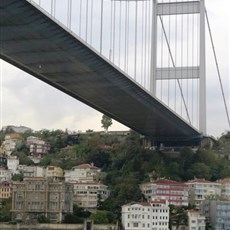
Bosphorus
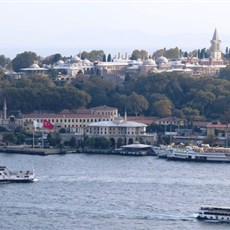
Topkapi Palace
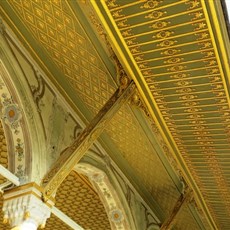
Topkapi Palace
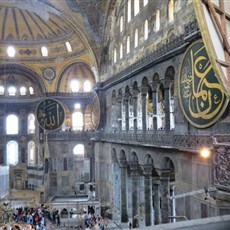
Aya Sofya
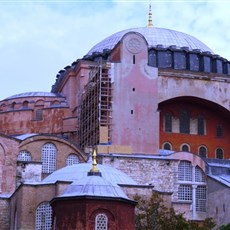
Aya Sofya
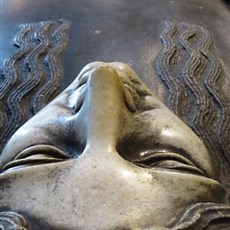
Istanbul Archaeology Museum

Istanbul Archaeology Museum
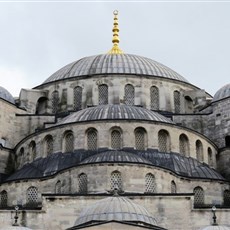
Blue Mosque - Sultanahmet Camii

Blue Mosque - Sultanahmet Camii
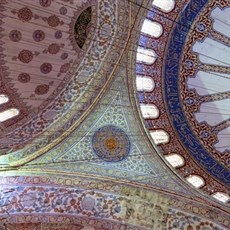
Blue Mosque - Sultanahmet Camii
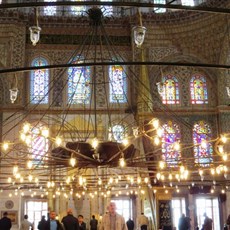
Blue Mosque - Sultanahmet Camii
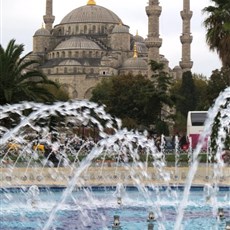
Blue Mosque - Sultanahmet Camii